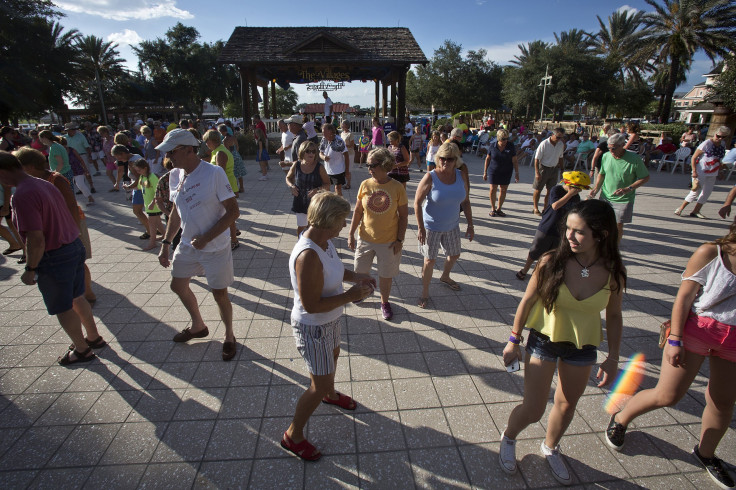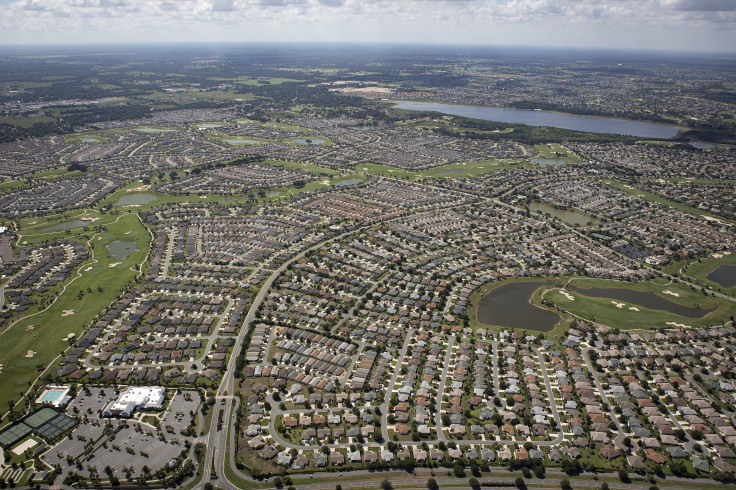America’s Largest Retirement Community Is Embracing Healthcare Driven By Family Doctors, Not Specialists

THE VILLAGES, Florida -- Last year, Carol LaCovey, 76, went to her first check-up at one of six brand-new healthcare centers recently opened in The Villages, a privately owned development in Sumter County that caters to legions of retirees. The manufactured city is famous for its golf courses and endless neat rows of carbon-copy homes. Lately, though, its developers have launched another amenity for residents -- a brand-new healthcare system.
LaCovey decided to try it out, entrusting her health to the same developers who have satisfied her and her fellow baby boomers lifestyle and social demands so successfully. She’s since returned for two appointments: one for a potential stress fracture and another for an infected toe.
“I have been extremely pleased,” she said from the kitchen of her home, a lazy breeze rustling the branches of a palm tree out front. “The doctor I see, she seems to know her medicine and the team is very good and efficient. When I was concerned, they got me right in."
Here in America’s largest retirement community, a handful of seasoned healthcare executives have spent tens of millions of dollars to build this healthcare system from scratch. Now its founders, along with their exclusive insurance provider UnitedHealthcare, say the 3-year-old project is showing early promise in improving patient care and satisfaction.
The expensive experiment is based on an innovative healthcare model known as “patient-centered medical homes” that is championed by a growing number of family doctors because it places them back in the center of the health system. Supporters say this model represents a future where healthcare is based in relationships with primary care physicians instead of specialty clinics and hospitals. Across the U.S., insurance companies and government agencies have tested the idea by funding large pilot projects and encouraged health practices to convert to the model by offering bonus payments in the neighborhood of $20 per patient per month to those that adopt it.
“The patients are generally far more satisfied, the quality is generally significantly higher and we are finally beginning to show some cost savings,” said Dr. Wanda Filer, president of the American Academy of Family Physicians. “We really believe we could lower our expenditure of gross domestic product on healthcare if we put that back into this model.”

American healthcare insurance has long been based on payments that incentivize speed and efficiency over thoroughness and diligence. As a result, doctors rush through 15-minute appointments with little follow-up and primary care physicians take a backseat to specialists who are paid more for their services.
“They don’t pay you for thinking, they pay you for doing,” said Dr. Elliot Sussman, chair of the new system called The Villages Health. “We threw all that out the window and we said, this model is going to be patient-centered, primary care-driven.”
Whereas many primary care physicians are strapped for resources and staff, a physician at a Villages health center is flanked by two assistants and has access to X-ray technicians and a team that can do basic lab work within the same facility. There is also a full-time audiologist on staff since many retirees struggle with hearing issues. A patient’s first visit typically lasts an hour, and each follow-up runs about 30 minutes. Doctors are limited to treating no more than 1,250 patients while the typical primary care physician might handle 2,500 to 3,500.
On a tour of one of five primary care centers The Villages has built to serve its residents, Dr. Jeffrey Lowenkron, chief medical officer, pointed out how treatment rooms are called “visit rooms” and nurses and doctors work in open “huddle zones” to encourage coordination on each patient’s care. The clinic's decor resembles a living room, with big couches and decorative lamps.
Gary Lovell, 71, likes the range of services provided at the new centers, but says his visits are similar to those at any other doctor. He goes in for a check-up every few months to manage his diabetes, and he’s impressed the new centers can do blood tests in-house. He has visited eight times in the past year.
After three years, both The Villages Health and UnitedHealthcare said the system is performing well compared with other managed care plans in the region. It’s too early to determine health impacts, but Pete Clarkson, CEO of UnitedHealthcare Medicare and Retirement in northern Florida, said he is pleased patients at The Villages Health are more likely to complete preventative services and screenings.
“We’re beginning to see evidence that suggests that this is an effective model and that The Villages Health system and their team of physicians are really pretty effective at managing care and managing outcomes,” he said.

Since The Villages is a privately owned development, its wealthy owners were able to build the system at an extraordinary pace, and could negotiate exclusive insurance coverage through UnitedHealthcare’s Medicare Advantage plans. From a “dead stop” in 2013, Sussman said, there are now 42,000 patients enrolled in the system -- nearly half the community.
It’s hard to say whether this model is transferrable to other communities. Certainly, there is broad enthusiasm for medical homes but The Villages Health is an aberration in both its ownership and the population it serves. Currently, at least 44 states have a federally supported medical home program and 18 have systems that are co-sponsored by the government and private insurers. Filer at the American Academy of Family Physicians said about 40 percent of members have converted their practices to medical homes.
“The concept of patient-centered medical homes has definitely taken hold and its implementation is growing across the country,” said Dr. Judith Steinberg of the University of Massachusetts, who led a three-year demonstration project for medical homes in Massachusetts and is currently overseeing a statewide effort to support even more.
Jay Millson, executive vice president of the Florida Academy of Family Physicians, says it’s easier for well-resourced physicians in The Villages Health to operate a medical home than it would be for a rural independent practice to do it. But Sussman said there will be lessons, at least, that can be shared with other communities even if the entire system isn’t easy to replicate.
“I think the reason United[Healthcare] was so eager to do this and has invested significant resources is at the end of the day, they really believe there are learnings here that are going to be transferable and scalable,” he said. “I happen to believe that’s true as well.”
© Copyright IBTimes 2024. All rights reserved.












